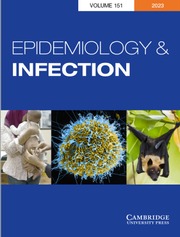We reviewed with interest Zhao's letter regarding our article exploring the approach of calculating the effective reproduction number (R eff) [Reference Huang1]. We entirely agree with Zhao et al. that it is essential to calculate the R eff by using the next generation matrix (NGM) approach. Actually, we also commonly used the NGM approach to calculate the reproduction number of other infectious diseases [Reference Cui2].
We did not provide the complex equation of R eff from the NGM approach instead of a simplified equation in our study [Reference Huang1], because in Xiamen City, the values of f, daily br and daily dr were 0.0003 (0.03%), 2.46 × 10−5 and 1.24 × 10−5, respectively, which were much lower than those of ω (1/5), γ (1/14) and γ’ (1/21), respectively. We also calculated the values of R eff by using the simplified equation we used and the two equations provided by Zhao et al., and we found that they were almost the same (Fig. 1).

Fig. 1. The values of R eff calculated by three equations in Xiamen City, 2014–2018.
Therefore, we agree to use an accurate approach to estimate the transmissibility of an infectious disease. However, a simplified equation would be easier to be performed by the primary public health department than a complex one.



